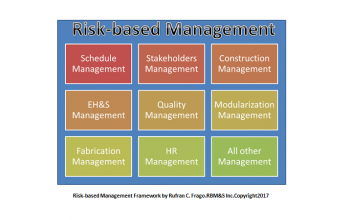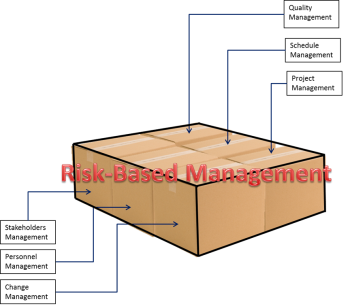Risk-based Management Framework

A project management framework is important in effectively managing projects. Planning and scheduling management framework is essential in managing plans and schedule. An engineering management framework governs engineering works as does a safety management framework provide standards and guidance to all safety works.
In these frameworks lie processes that are fundamental to each management area. The creation and development of the basis of project schedule provides inputs to the creation and development of the project schedule. They are part of the framework that manages project planning and scheduling.
In all the aforementioned frameworks, processes, and knowledge areas, there is one common element to manage, and that is risk.
“Risk is a primary concern in pursuit of any goal. Risk is not only a factor or featured element of all management. It is the main character at play. Risk-based management gives importance to objectives. Failing to mitigate the risk means failure to meet the objective/s ( Frago, R., 2015.Amazon.com\Risk-based Management in the World of Threats and Opportunities: A Project Controls Perspective)."
One can logically conclude that risk-based management is the mother of all management.A project framework has to exist, aligned to the overall risk-based management strategy. It is the acceptable strategy to manage effectively a good size project.
The project management framework is a component framework inside the risk-based management framework. It is the most rational way to look at it. A risk-based approach to business management is the foundation of all successful endeavors. It governs the process of planning and scheduling that leads to the end goal. It influences all types of management, be it quality, personnel, safety, or project as a whole.
If one stops for a moment to imagine how the field of management is structured, it should be easy to conjure an image of a box within a box within a box and so on; i.e. a framework within a framework within a framework within a framework, etc.
The question that follows is this, “Which box is within what box?”My view perfectly follows the concept that risk-based management encompasses all human endeavors. Unlike the typical presentation known to project practitioners worldwide, I have to say and ultimately conclude that in my professional perspective, the biggest box in the field of management is risk-based management.
Within it are all the other boxes, including project management and all management elements that comes with it such as quality, safety, cost, schedule, and others (Figure 1).
Regardless of how we arrange the boxes, like putting one framework inside or over another, or coming up with box combinations, the control box is risk-based management.
Everything we do is a form of risk-based management. This simple, all-encompassing statement might come to some people rather strongly but accepting it as true declaration is important. A motherhood statement such as this might prove controversial in many fronts where traditional thinking has deep roots. I can only hope that by stating my view, some will stand with me on the same footing and be able to appreciate what I meant to convey.
To appreciate the all-encompassing concept, one has to understand deeply.

Whatever we do affects ours or someone’s end-result to a certain degree. Whether we admit it or not, we pursue a personal or business intent daily. This is regardless of where we are, what we do, and what we do not do.
We consciously, semi-consciously, or unconsciously manage risks (risk-based management) as we go through the process of living, doing, and pursuing objectives. In effect, more so in the personal level, in all practicality, a risk-based framework confines everybody.
In the pursuit of quality, the organization has to mitigate or prevent threats to the quality objective. The same reasoning with the objective of cost underrun, a project delivered on time (timely schedule), a project with no loss time injury, etc. Success is only possible when risks are managed well. Risk-based management is in the core of each.
Schedule management framework is a component framework within Project Management. The same is true with cost management and quality management. They are all in a risk-based envelope, within a risk-based network, of a risk-based system.
A framework is the logical demarcation line governing what needs considered in the risk-based process. In project management, it includes project execution plans and all its sub-components.
It is an envelope that puts a logical and intelligent bracket of limitation to what a business should evaluate, plan, and execute. It gives stakeholders more sense of control and direction.If no limit is set, businesses start analyzing infinite sources of data that might compound even the brightest person in the simplest situation. The need to establish a boundary is a no-brainer. The probability of arriving at an answer can become more elusive in the absence of focus and control.
At our present technology, advance as it is, we still analyze information crudely. More information still amount to nothing when taken against important and specific objectives. Having collected information does not necessarily translate to good information. Good information is qualified against its usefulness and timeliness.
Relevant data required for mitigation or enhancement becoming available after the risk event has occurred is useless. Unrelated information cannot create a picture to drive a conscious decision. Correlation is required to come up with a calculation and a subsequent intelligent analysis. Raw data, more often than we think, is logically useless.
Venturing out into the great and expansive risk universe without a risk-based framework even with the complete and massive data will only tend to muddy the water, and even drown us in confusion and utter frustration.Risk-based management framework is like a picture frame, perhaps a hockey rink, or a football field to name some figurative comparisons. It helps all to see the best view of a situation with respect to current objectives.
It puts everyone practically on the same venue, on same footing, and observing the same playing area.
These types of confines make rules possible! It is similar to how road traffic operates. The control space is closely associated with the things in play, tailored to the objectives.
Good comprehension of the framework helps businesses understand, formulate plans, execute, and successfully close out while at the same time, managing risks.
It establishes the right reference point and boundaries that facilitates operational excellence and benchmarks.
It gives us the ability to forecast, measure performance, and judge the difference between real success and failure.
Rufran C. Frago – Author (050917)
• https://www.amazon.com/author/rufrancfrago
• https://youtu.be/LDESPW6OYkg
Related sites:
• Risk-based Management and Services Inc. Facebook
• Your World, Our Risk Universe: Wordpress
• LinkedIn Professional Website
Related articles authored by Rufran Frago.
1. Diversity Risk-Case 1: Nho Klu
2. Diversity Risk in the Canadian Workplace
3. Diversity Risk Case 2 : Puro Mali
6. Man is the Center of the Risk Universe
7. Project Schedule Baseline Top 10 Prerequisites
10. Primer to Good Schedule Integration
 Printer-friendly version
Printer-friendly version- Login or register to post comments
 Send to friend
Send to friend




